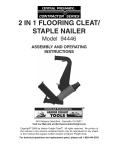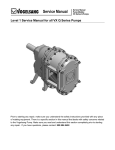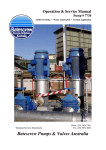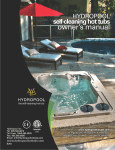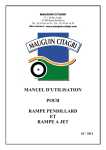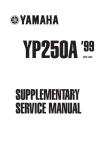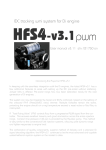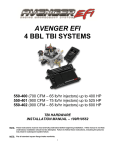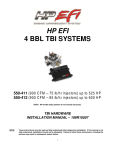Download Service Manual Service Manual
Transcript
Service Manual Service Manual Pumps Models: VX Series QD Pumps Level 1 Service Manual for all VX QD Pumps Prior to starting any repair, make sure you understand the safety instructions provided with any piece of rotating equipment. There is a specific section in this manual that deals with safety concerns related to the Vogelsang Pump. Make sure you read and understand this section completely prior to starting any repair. If you have questions, please contact: 800.984.9400 Service Manual Service Manual Pumps Models: VX Series QD Pumps Depressurize QD Door & Buffer Chamber IMPORTANT: If your pump is equipped with a pressurized oil canister and you are working on the mechanical seals in either the QD door or Gear Box end of the pump, you must depressurize each chamber before you remove the seals. Whenever the mechanical seals are removed from the pump, a pressure test is highly recommended after re-installation of the mechanical seals and wet-end parts. This test will confirm that installation has been successful and no o-rings have been cut or pinched in the process. The pressurized oil bottle itself is ideal for this pressure test. Pressure Testing: 1. Test for proper seal installation: Install a pressurized oil bottle at the empty buffer chamber port at the top of the pump. With the provided hand pump or other air source, pressurize the bottle (no oil in chamber) to approximately 21 psi (1.5 bar) and observe the gauge. Pressure should hold steady for at least 15 minutes. Then depressurize the bottle, remove it, re-fill the buffer chamber and reinstall the pressurized oil bottle. A specific pressure is to be set on the oil bottle which is specific to your pump’s operating pressure. Review the following page for instructions on determining and setting the pressure for your pump’s buffer chamber. 2. If the buffer chamber does not hold pressure it will be necessary to disassemble and recheck all o-rings for damage, and the lobe core surfaces for proper preparation. Check also that the seal cartridge is seated fully into the pump body and the cartridge outer body is flush with pump body. 3. Re-install pump outer door (front pump cover) to complete assembly. Use the included Hand Pump to add pressure inside the empty blocking chamber. 21psi equals about 1.5 bar on your pressure gauge. Service Manual Service Manual Pumps Models: VX Series QD Pumps Repressurizing Pump after completed maintenance The pressurized buffer chamber canister (oil bottle) provides a constant pressure against the mechanical seal helping to prevent infiltration of material from a higher pressure in the pumping chamber. The semi-opaque container also allows easy monitoring of the oil level. 1. Fill the buffer chamber completely using the same oil as that used in the gearbox, ie. 80W90 hypoid gear oil. 2. If a non-pressurized oil bottle has been previously installed, remove and discard the bottle and the check valve installed under the bottle. Install the pressurized oil bottle, screwing it directly to the buffer chamber. On belt drive units, a hose kit is necessary to mount the bottle in a remote location. 3. Fill the pressurized oil bottle about 1/4 full with buffer chamber oil (see above). Using the supplied hand pump, pressurize the buffer chamber using the formula: 1/2 of normal pump operating pressure plus 7 psi. For example, if your pump normally has a pressure head on the suction side of 2 psi and a discharge pressure of 30 psi, the operating pressure is 32 psi. Pressurize the oil bottle to (1/2 x 32) + 7 = 23 psi. It’s as easy as a b c. Just fill in the blanks: Step Suction Pressure a Discharge Pressure b ½ Differential Pressure Equals Operating Pressure = + Operating Pressure c Plus Equals Divided by ÷ 2 = Plus PSI Equals + 7psi = ½ Differential Pressure Gauge Pressure Service Manual Service Manual Pumps Models: VX Series QD Pumps Drain Pump Oil Reservoirs NOTE: Depending on the type of mechanical seal installed, the pump may be supplied with a pressurized oil bottle. In this case, remove pressure and unscrew oil bottle from the pump. If the non-pressurized oil bottle is used, remove the check valve with the bottle. Front Cover Drain Fig. 1 Buffer Chamber Drain Vogelsang QD pumps have three oil reservoirs: Front Door, Buffer Chamber and Rear Gear Box. All chambers may use the same Titan Gear MP90 mineral oil, SAE90. To begin service to the pump wet-end drain oil from the QD door (Fig. 1 Referred to as the bearing housing in the parts list) buffer chamber by loosening and removing the bottom drain plug. Remove the pressurized oil bottle from the top of the chamber at the same time. Place it in a safe place for reuse. Place a drain pan under the pump to catch the quenching oil. Remove the buffer chamber drain bolt (Fig. 2) located on the bottom of the pump. This part will be reused. Inspect the oil for foreign bodies or other evidence of contamination, as this may indicate mechanical seal failure. Gear Box Drain Fig. 2 Remove the top bolt on the gear case of the pump, and save for re-use. Place an oil collection pan under the pump, and loosen and remove the bottom drain plug from the gear case of the pump. Inspect the oil for foreign bodies and other contaminants. This may be an indicator of mechanical seal performance, or gear/bearing damage Service Manual Service Manual Pumps Models: VX Series QD Pumps Removing QD Door including Mechanical Seals & Wearplate Use a 19mm socket or wrench to remove the 12 nuts around the perimeter of the QD door (Fig 3). Use the allen tool provided with the Vogelsang lobe puller tool to remove the strain screws (Fig. 4) from the lobe shafts. Notice that this tool is equipped with a specially designed tip which acts as a guide to hold the tool in alignment in the bolt head. Use of a standard metric allen wrench may lead to “round out” issues in the bolt head. Retaining Nuts QD Pump Door Fig. 3 Fig. 4 Service Manual Service Manual Pumps Models: VX Series QD Pumps Remove two of the bolts for use as jacking bolts to remove the door (Fig. 5) from the wet-end of the pump. These bolts are used to pull the sealed front door away from the wet-end of the pump without forcing or prying on it. Screw one bolt into the top threaded hole provided in the cover. (Fig. 6) Screw the second bolt into the bottom threaded hole provided in the lower end of cover. (Fig. 7) Fig. 5 Fig. 6 Fig. 7 Service Manual Fig. 8 Service Manual Pumps Models: VX Series QD Pumps Alternating from top to bottom bolt, tighten each bolt until the door comes loose. The door will be very heavy so be prepared to support it as it comes out of the wet-end housing segment. The remaining perimeter bolts will provide temporary support as the door comes loose. Fig. 9 Fig. 10 Pull the door away from the wetend of the pump. Make sure you have a good grip on the door as it is very heavy (Fig.10). Note: If you are performing a lobe change or are not working on the door wear plate or door side mechanical seals, you may skip ahead to the next appropriate section: Removing Rotary Lobes: Fig 62 Fig. 11 Lay the door on a firm, flat surface that supports the weight of the door (Fig 11). Service Manual Fig. 12 Service Manual Pumps Models: VX Series QD Pumps Use external snap-ring pliers to remove the retaining snap ring (Fig 12 & 13) holding the o-ring carrier in place. Repeat process on other seal if replacing or removing both. Note: You do not need to remove any part of the seal if you are just replacing the wear plate. If this is what you’re doing, then skip to Fig 20. Fig. 13 Fig. 14 Remove the o-ring (Fig 14). It is easiest to use a pick to dig the seals out of their track. Note: You must replace ALL orings having to do with mechanical seals.This o-ring composition must match the elastomer used in the pump. Take care when ordering parts that the full model number of the pump is disclosed. All o-rings come with the replacement mechanical seal kit. Service Manual Fig. 15 Service Manual Pumps Models: VX Series QD Pumps Use a flat tool similar to a screwdriver or chisel to work the carrier up and off of the sleeve (Fig 15 & 16). Use a nut as a fulcrum to make it easier to loosen the carrier. Repeat this procedure for top and bottom shaft if removing second seal. Any Nut Fig. 16 Remove the o-ring and washer (Fig 17 & 18) Use an o-ring pick or similar device to work the second o-ring (Fig 19) from between the sleeve and the cartridge seal. Any Nut Fig. 17 Fig. 18 o-ring will be deep in groove Fig. 19 Service Manual Pumps Models: VX Series QD Pumps Service Manual Fig. 20 Use a 17mm socket or wrench to remove the two bolts retaining the wear plate to the bearing housing (Fig 20 & 21). It may be helpful to use a flat screwdriver or similar device to lift one edge of the inner wear plate, then lift the plate free of the gear housing. Fig. 21 Remove retaining bolts Fig. 22 Once the wear plate is loose, (Fig 22) then simply remove the plate by hand (Fig 23). With the wear plate removed, the mechanical seals are exposed and can be removed (Fig 24). Fig. 23 Fig. 23 Fig. 24 Service Manual Pumps Models: VX Series QD Pumps Service Manual Fig. 25 Use the Vogelsang seal assembly tool to remove the cartridge style seal assembly from the bearing housing (Fig 25). Align the inner holes on the tool with the threaded holes in the mechanical seal stationary housing (Fig 26). Note: the threaded holes in the mechanical seal stationary housing may hold an allen-head set screw designed to keep material from building up in the threaded hole and damaging the fine threads. Remove this set screw first, using a 1.5mm allen wrench. Fig. 26 Fig. 27 Install the supplied mounting screws to bolt the removal tool to the stationary carrier housing. Use a 5mm allen head wrench to tighten the mounting bolts (Fig 27 & 28). You are attaching the removing tool to the mechanical seal. Fig. 28 Service Manual Pumps Models: VX Series QD Pumps Service Manual Fig. 29 Use the supplied long bolts to the outer threaded holes of the assembly tool. Hand tighten, then, using a 10mm wrench, turn each bolt 2-3 revolutions and move on to the next, gradually moving around the assembly tool several times as the mechanical seal assembly is lifted from the bearing housing (Fig 29 & 30). Note: It is possible for the seal carrier to be very firmly embedded in the bearing housing. If necessary, use just one turn per screw in a circular fashion until the carrier Fig. 30 begins to move. Attempting to remove the carrier before it is ready to move may result in bending the tool and rendering it useless. Fig. 31 Lift the mechanical seal cartridge and tool from the housing. Remove the tool from the cartridge assembly and repeat for the remaining mechanical seal (Fig 31). Service Manual Pumps Models: VX Series QD Pumps Service Manual Fig. 32 With the cartridge assembly removed, use an o-ring pick or similar tool to pull the o-ring from the cavity. If no further service to the QD door is necessary, proceed to the seal installation section at this point. Removing QD Door Bearings, Shaft Sleeves & Lobe Retainers Fig. 33 To service the bearings and the lobe retaining hardware, first flip over the QD door. Use a 17mm wrench to remove the four bolts holding the bearing cover to the housing (Fig 33). Note: The two outside bolts are longer than the two inside bolts on each cover (Fig 34). Remove 4 bolts Fig. 34 Bolts are 2 lengths Service Manual Fig. 35 Service Manual Pumps Models: VX Series QD Pumps Use a blade screwdriver or similar tool to gently pry the cover from the housing (Fig 35). The cover will be filled with with a lithium complex grease, NLGI Grade 2, similar to the Chevron product Ulti-Plex Greases EP. However, any grease which meets the NLGI Grade 2 classification will be suitable (Fig 36). Fig. 36 Fig. 37 Remove the pressure disk and seal sleeve as a unit. Should you need to replace one or the other, disassemble the unit. Otherwise, it may be removed and replaced as a unit (Fig 37 & 38). Fig. 38 Service Manual Fig. 39 Service Manual Pumps Models: VX Series QD Pumps The spring washer (Fig 39), although a separate part from the pressure disk, snaps onto the pressure disk assembly and does not easily slip off the center spool. If this assembly is undamaged it may be reused. To service the three pressure disks, remove the spring clip using a flat blade screwdriver or similar tool to work the clip away from its groove then lift and hold with a second tool to remove. Fig. 40 Note the position of the three pressure disks (Fig 40) as they are removed. Each is slightly convex. Note that the convex surfaces of the two inner spring washers face each other, while the concave surface of the outer spring washer faces the concave surface of the washer below it. The position of the washers in relation to each other is important to maintain the tension designed into the lobe retention system. Fig. 41 Service Manual Fig. 42 Service Manual Pumps Models: VX Series QD Pumps Should service to the bearing or bearing race be required, drive the sleeve from the bearing carefully with a plastic hammer (Fig 42). The sleeve will be removed as an assembly with the bearing race (Fig 43) locking sleeve and ring. Should service to this assembly be required, please refer to the bearing sleeve assembly section. Fig. 43 Fig. 44 If no service is necessary, this part does not have to be removed. To disassemble the shaft sleeve, unscrew the angle ring (Fig 44). Note: When reassembling, make sure that the angle ring is screwed in until it is properly aligned with the surface of the sleeve (Fig 45). Fig. 45 Service Manual Fig. 46 Service Manual Pumps Models: VX Series QD Pumps Remove circle clip followed by spring washers if not previously removed. Then remove the dowel from inside the sleeve (Fig 46). Note: When reassembling, the dowel has to be inserted gently into the sleeve. Do use a hammer on the dowel. The bearing (Fig 47) can be removed once the sleeve assembly has been driven out. Use a stout hammer and drift to remove the bearing. Fig. 47 Service Manual Service Manual Pumps Models: VX Series QD Pumps Reassembling QD Door including Mechanical Seals & Wearplate Fig. 48 Working in reverse. Start by reassembling the bearings and inserting shaft sleeves. Reinstall the sleeve assembly in the bearing using a hammer to gently tap the sleeve into the bearing on the bearing race. Do not use excessive force. The race should be well greased to ease installation (Fig 48). Fig. 49 Tap on outer ring only Fig. 50 When reinstalling the bearing cover ensure the o-ring (Fig 49 ) is in place. The o-ring may be coated with grease to hold it in place. The use of oil or grease on the o-rings during installation is encouraged. Before installing cover, make sure the pressure disk assembly (Fig 50) is in place, and the separate pressure disks have been correctly installed. Service Manual Service Manual Pumps Models: VX Series QD Pumps Fig. 51 Tap the cover into place taking care that the o-ring seal is in place and not pinched in the cover (Fig 51). Do not overtorque the bolts. A snug fit is sufficient (~40 ft. lbs.) Fig. 52 Flip door over to begin installation of mechanical seals Installation of the Blockring or cartridge mechanical seal begins with the installation of the inner oring (Fig 52). Note that this oring must be of compatible material to the elastomer of the lobes. Normally, this o-ring is NBR as are the lobes. Should your pump have non-standard elastomers, this o-ring must match that elastomer. Service Manual Fig. 53 Service Manual Pumps Models: VX Series QD Pumps Oil the sleeve and the inner bore of the mechanical seal and slide the cartridge assembly over the sleeve (Fig 53). Note that the oring (pos. 34) has been installed on the body of the mechanical seal cartridge (Fig 53). Tap only (Fig 54) on the outer stationary housing of the mechanical seal cartridge. Be careful not to hammer on the inner rotating core of the cartridge as this may damage the mechanical seal. Tap gently around the perimeter of the cartridge to seat it all the way into the bearing housing. Fig. 54 Lay the o-ring (Fig 55) into place around the perimeter of the stationary housing of the cartridge seal assembly. It is not necessary to push this o-ring into the groove formed between the cartridge and bearing housing as the o-ring will be seated properly by the wear plate when it is installed. Tap on outer ring only Fig. 55 Note: This o-ring must be of compatible material to the elastomer of the lobes. Normally, this oring is NBR as are the lobes. Should your pump have non-standard elastomers, this o-ring and the one on the body of the cartridge must match that elastomer. Service Manual Fig. 55 Service Manual Pumps Models: VX Series QD Pumps Install the door wear plate (Fig 55). Ensure the wear plate fits snugly against the bearing housing indicating that the mechanical seal is fully installed. Install o-ring (Fig 56) around bearing sleeve. This o-ring does not have to be pushed into place as the installation of the o-ring carrier will fully seal the o-ring. Over that, install the thin washer and second o-ring. Fig. 56 Don’t push into groove Service Manual Fig. 57 Service Manual Pumps Models: VX Series QD Pumps Place the o-ring carrier (Fig 57) over the end of the bearing sleeve and push into place. Use a plastic hammer to carefully seat the carrier until the snap ring groove is fully exposed (Fig 58). Fig. 58 Use snap-ring pliers to seat the snap ring (Fig 59) into its groove above the o-ring carrier. Tap on outer ring only Fig. 59 Service Manual Fig. 60 Service Manual Pumps Models: VX Series QD Pumps Wet the o-ring (Fig 60) with oil and seat in the groove provided by the o-ring carrier just installed. Before reinstalling the QD Door be sure to install the sealing oring (Fig 61). If this o-ring is not excessively compressed or cut it may be reused. Fig. 61 The door is now ready for re-installation. Sealing o-ring Service Manual Service Manual Pumps Models: VX Series QD Pumps Removing Rotary Lobes Fig. 62 Fig. 63 After the QD Door has been removed and serviced, if necessary, lobe change is accomplished using the optional lobe puller tool as illustrated (Fig 62). Lobes must be pulled out in pairs, top and bottom together. Although this can be accomplished using only one lobe puller tool, the use of two in tandem is recommended. Attach the lobe puller arms into the ends of the lobes, engaging machined grooves. Tighten the arms with the attached wing nuts and steadily rotate the center screw of the tool clockwise until the lobe begins to move outward. Then switch to the other tool and repeat. Going back and forth from tool to tool (or removing the tool from one lobe and connecting to the other, if only one tool is being used), continue until the lobes come loose from the shafts. Each lobe weighs approximately 30 lbs. so exercise care when removing each from its shaft. The lobes will be removed in pairs, and one cannot be removed without pulling its mate simultaneously (Fig 63). Service Manual Fig. 64 Service Manual Pumps Models: VX Series QD Pumps With the second set of lobes exposed, remove the cover disk around the core of each lobe before attempting to attach the lobe puller (Fig 64). Remove the second set of lobes in the same manner as the first, pulling both top and bottom lobes together until they slide off the shaft (Fig 65). If your pump has a third set of lobes, they are removed in the same fashion. Cover Disk Fig. 65 Service Manual Service Manual Pumps Models: VX Series QD Pumps Removing Cartridge Mechanical Seal Surface is free of gouges or elastomer fragments. Before continuing with cartridge seal replacement: Important! Once you’ve removed the lobes, you must evaluate the condition of the lobe core that will contact the Block Ring. Lobe condition is critical to prevent premature seal failure. Lobes provided before the development of the Block Ring seal may have partial coating on the inner core which mates with the seal. These lobes may show small bits or pieces of the coating in a jagged appearance around the surface which is not acceptable when using Block Ring seals. Surface has even elastomer coating with no gouges. New lobes have a smooth, clean, machined appearance and show no jagged bits of coating. If lobes are being reused with the Block Ring seal, attention must be given to the condition of the lobe core, assuring that it has not been damaged. Unacceptable: Jagged pieces of coating on inner core can lead to seal failure. Service Manual Fig. 66 Service Manual Pumps Models: VX Series QD Pumps With the aid of a hammer and chisel, carefully tap the keys (Fig 66) from their keyway, and remove from the pump. Discard the keys, as they cannot be used again. Remove any burrs from the shaft with the aid of a file or emery cloth. Take care not to injure yourself on the sharp edges of the keyway. Fig. 67 Carefully reach into the pump, and remove the wave washers (Fig 67) from the shaft. If replacing the cartridge or block ring mechanical seal assembly, these parts will be included and should be replaced. If changing just the lobes they may be re-used, but replacement is recommended. Note: Washers (Fig 67) go on top and bottom shaft. Re-install them in the same location from which they were removed. Service Manual Fig. 68 Service Manual Pumps Models: VX Series QD Pumps Using a dental pick, o-ring puller or similar sharp instrument, remove and discard the o-ring (Fig 68 & 69) located around the pump shaft. Note: Never re-use this o-ring. Fig. 69 Service Manual Fig. 70 Service Manual Pumps Models: VX Series QD Pumps Loosen and remove the two bolts (Fig 70) holding the rear wear plate. Inspect the bolts for wear. If in good condition, retain for reuse. If damaged, discard and replace during re-assembly. Remove wear plate. Inspect for wear. If in good condition, re-use. If damaged, replace. As with the outer wear plate, some wear is expected. Excessive wear is determined by loss of flow performance. When pump flow is unsatisfactory the plate must be replaced. This plate can never be turned over for re-use. Fig. 71 Note: The back wear plate has a slight convex bend to it (Fig 71). The plate is installed one-way only, with the ends of the plate pushing the center up slightly. The retaining screws bring the plate flush to the pump body and provide tension to the assembly. Service Manual Fig. 72 Service Manual Pumps Models: VX Series QD Pumps Remove the o-ring (Fig 72) at the top of the mechanical seal cartridge assembly. Discard the o-ring and replace. This o-ring is provided with the mechanical seal assembly if the cartridge is being replaced. New cartridge and block-ring seal assemblies are supplied with 2 small set screws on opposite sides of the outer carrier of the assembly. Remove these small screws using a 2.5mm allen wrench (Fig 73). These set screws are installed to help keep material out of the threaded holes in the carrier used by the cartridge removal tool. Fig. 73 Special Tool Required Service Manual Fig. 74 Fig. 75 Service Manual Pumps Models: VX Series QD Pumps Place the cartridge removal tool ring over the shaft of one cartridge assembly at a time. Install two retaining screws to attach the ring to the outer edge of the carrier on the seal assembly, and thread three jacking screws into the removal tool ring (Fig 74). As the jacking screws are tightened into the ring and against the pump housing, the ring will pull the cartridge assembly out of the seal bore. Pull entire seal assembly up off the lobe shaft. Repeat the procedure for the other mechanical seal assembly. Use an even, slow pressure with the jacking bolts to avoid bending the assembly tool ring. Turn each screw one or two turns at a time, and rotate around the ring increasing pressure with the jacking screws (Fig 75). Note: If re-using a mechanical seal assembly, the o-ring around the outer circumference of the assembly must be replaced. This o-ring is part of the seal assembly kit when ordered new. Service Manual Fig. 76 Service Manual Pumps Models: VX Series QD Pumps Remove the o-ring (Fig 75 ) from the case. This is the same size o-ring as the one on the outer circumference of the seal assembly. Caution: The large o-rings used with the mechanical seal assembly are all the same size. However, the o-ring used at position 34 may be of different material depending on the elastomers used in the pump. All elastomers are standard as NBR, but optional elastomers may be provided, if specified, to combat reaction to specific chemicals being pumped. Note: This completes the mechanical seal removal procedure. The entire wet-end is now disassembled. If you need to work on the pump’s gearbox end, skip to that section at this point. Service Manual Service Manual Pumps Models: VX Series QD Pumps Installing Block Ring Mechanical Seals Each Block Ring Mechanical Seal Kit Includes: Block Ring Mechanical Seal, 4 o-rings, flat washer, pressurized oil bottle and hand pump. Do not reuse your old parts. Do not use Non-pressurized glass oil bottle with Block Ring Mechanical Seals. Pressurized plastic oil bottle includes hand pump (included in kit) Note: If you are upgrading to our new Block Ring mechanical seal, you may have our old style nonpressurized oil bottle. All Block Ring seals require a pressurized oil bottle (included in the kit), and the pressure will depend on your particular application. Follow the instructions in the Oil Bottle InstructionsSG.Poilbottle.001 to set the appropriate pressure in the oil bottle. Service Manual Surface is free of gouges or elastomer fragments. Service Manual Pumps Models: VX Series QD Pumps Before continuing with cartridge seal replacement: Important! Once you’ve removed the lobes, you must evaluate the condition of the lobe core that will contact the Block Ring. Lobe condition is critical to prevent premature seal failure. Lobes provided before the development of the Block Ring seal may have partial coating on the inner core which mates with the seal. These lobes may show small bits or pieces of the coating in a jagged appearance around the surface which is not acceptable when using Block Ring seals. Surface has even elastomer coating with no gouges. New lobes have a smooth, clean, machined appearance and show no jagged bits of coating. If lobes are being reused with the Block Ring seal, attention must be given to the condition of the lobe core, assuring that it has not been damaged. Unacceptable: Jagged pieces of coating on inner core can lead to seal failure. Service Manual Service Manual Pumps Models: VX Series QD Pumps Installing Block Rings Seals: Install the new o-ring around the outer body of the new mechanical seal cartridge, liberally coating the o-ring and the inside race of the seal assembly with buffer chamber oil (Fig 77), and slide the cartridge seal and seal removal tool (no bolts) onto shaft and push into the pump body as far as possible by hand (Fig 78). Fig. 77 Fig. 78 Lubricate the shaft and slide in the lobe (without key in keyway) against the removal tool (Fig 79). Use the existing pressure disks and strain screw and draw the lobe against the pump body, thereby seating the mechanical seal (Fig 80). Remove the screw, pressure disks, lobe and removal tool. Repeat this procedure on the other shaft. Fig. 79 Fig. 80 Service Manual Service Manual Pumps Models: VX Series QD Pumps Liberally coat seal outer o-ring with buffer chamber oil, and set o-ring in place. Do not attempt to seat the o-ring between the seal body and the pump body. This will occur upon final assembly and tightening of the lobes (Fig 81). Coat the smaller o-ring with oil, and slide over shaft and against the seal inner race. Take care that the o-ring is not cut by the sharp edges of the keyway (Fig 82). Fig. 81 Install the flat washer over the shaft and against the o-ring (Fig. 83). Fig. 82 Fig. 83 Service Manual Service Manual Pumps Models: VX Series QD Pumps Place wear plate (Fig 84 pos. 37) into the pump, insuring that the chromed or ceramic side is facing both you and the wet-end of the pump. Install the two screws (Fig 85 pos. 38) that hold the wear plate (pos. 37) in place, and tighten securely. DO NOT USE AIR TOOLS for this operation. Hand tools only. Rotary Lobes are now ready to be installed. Fig. 84 Fig. 85 Service Manual Service Manual Pumps Models: VX Series QD Pumps Rotary Lobe Installation Install a new key or keys (Fig 86) into the shaft keyway. Take care to insure it is flush with the front end of the shaft. Fig. 86 Fig. 87 Inside Lip With the aid of a brush, lubricate the shaft, key, and insides of the lobes with hydraulic oil. Install the lobes (Fig 87) taking care that the inside lip is facing you. Pumps equipped with only two lobes should have a left lobe on the top, and right lobe on the bottom shaft. In the case of multiple lobes, you alternate one left, then one right lobe per shaft, until all lobes are installed. The reverse is true on the other shaft. The lobes should form a “V”. Service Manual Service Manual Pumps Models: VX Series QD Pumps QD Door is now ready to be reinstalled (Fig 88). Replace the O-ring (Fig 88). Place the QD Door on the pump, insure it is seated into it’s groove (Fig 89). O-Ring Fig. 88 Fig. 89 Service Manual Service Manual Pumps Models: VX Series QD Pumps Securely tighten the twelve retaining nuts (Fig 90). Note: Old Strain Screws CANNOT be re-used. Install only new Strain Screws. Lubricate the thread of the strain screw with hydraulic oil, and install by hand only until it cannot be tightened any further by hand. Repeat on other shaft. Retaining Nuts Fit lobe socket to torque wrench, and torque each of the strain screws (Fig 90) to the following: Insert Strain Screws in top & bottom shafts. Torque Required: VX186 Series = 147 f/lbs. Fig. 90 Then loosen each strain screw and re-torque each to 100 f/lbs. Note: Review the section on Adding Lubricants for instructions about the proper method to refill the pump buffer chamber and gear box with the appropriate lubricants. Fig. 91 Service Manual Service Manual Pumps Models: VX Series QD Pumps Disassembly of Gearbox To service the gear end of the pump remove 10 M10x40 metric cap screws around the perimeter of the gear case. Use an 8mm allen wrench extended socket if available. Inspect the split lock washers and replace if necessary. The bolts may be re-used. Note: If the shafts will be removed, it is necessary to remove the lobes and mechanical seal assemblies first. To service the bearings or gears, the shafts must be removed. With the aid of a hammer and chisel, carefully tap the key from its keyway, and remove from the pump. Discard the key, as it will not be used again. Remove any burrs from the shaft with the aid of a file or emery cloth. Take care not to injure yourself on the sharp keyway edges. Service Manual Service Manual Pumps Models: VX Series QD Pumps Use a blunt drift in the recesses provided between the gear case and the pump body. Never hammer against the feet of the pump. The gear case uses four dowels to position and hold the case to the body. It may require several blows against the drift at various points around to loosen the case. Once the cover has been loosened, the use of a chisel or similar tool can aid in further removing the case from the 4 dowels used to hold it in place. Use care to loosen the case evenly around the pump body. Service Manual Service Manual Pumps Models: VX Series QD Pumps Once loosened the case can be lifted off the shafts and put aside. Two bearings reside in the case, as well as the lip seal for the outboard shaft end and the cap seal for the inboard shaft opening. These will be serviced later, if necessary. Special Tool Required Service Manual Service Manual Pumps Models: VX Series QD Pumps Remove the case sealing o-ring. Vogelsang recommends replacing this seal whenever the case is removed, but if it is undamaged and does not indicate excessive compression it may be re-used. Drive the two shafts from the wet-end of pump through the gear end of pump. Use appropriate drift and heavy hammer as shaft is a tight fit through the double roller bearing. Note: Provide soft landing for the shafts as they leave the pump body, or use a helper to hold shafts as they are driven out of the pump. Service Manual Service Manual Pumps Models: VX Series QD Pumps Pump body with shafts removed. Use a hammer and chisel to bend the locking washers away from the retainer bolts. The bolts may be re-used. Service Manual Service Manual Pumps Models: VX Series QD Pumps Use a 17mm wrench to remove the bolts around the bearing retainers. Discard the locking washers and replace with new. Drive the roller bearings from the pump body. Note use of special tool to avoid damaging the bearing if it is to be re-used. Service Manual Service Manual Pumps Models: VX Series QD Pumps The bearing assembly should emerge from the pump body bore intact. Thoroughly clean the area with a fast-drying solvent. We typically use a good quality brake cleaning product to remove all traces of old oil and grease. Service Manual Service Manual Pumps Models: VX Series QD Pumps Reassembly of Gearbox Apply liberal coats of oil to all parts during reassembly of pump. Drive bearing assembly fully into the pump body using an appropriate tool to avoid damage to bearing. Service Manual Service Manual Pumps Models: VX Series QD Pumps The bearing housing should be flush with the pump housing when fully seated. Install bearing retainers using new locking washers. Bolts may be reused if undamaged. Service Manual Service Manual Pumps Models: VX Series QD Pumps Use a hammer and chisel, or similar tool, to bend one edge of the locking washer up against the retainer bolt head. Inspect assembly to assure that no locking washer edge extends over the o-ring seat on the corners, as this may impede the re-assembly of the gear case. If it is necessary to replace the shaft or gear it will be necessary to build an entire new shaft assembly. Carefully inspect the parts list for correct parts for the shaft being rebuilt. First install the key for the gear. Service Manual Service Manual Pumps Models: VX Series QD Pumps Align the shaft key with the gear keyway and drive the shaft through the gear until the key aligns with the face of the gear. The shaft has been driven through the gear and the keyways are aligned. Final position of gear is created when spacers and bearing race have been installed. Service Manual Service Manual Pumps Models: VX Series QD Pumps Install spacer on the gearbox end of the shaft, up against the gear face. Then drive the bearing race for the bearing over the shaft and past the cut groove in the shaft. Install the circlip into the groove to hold the bearing race in place. Install the bearing side spacer. If the drive shaft is being assembled, note that a race must be installed above the circlip to accommodate the lip seal installed later. Service Manual Service Manual Pumps Models: VX Series QD Pumps When driving the shafts back into the pump, take care to properly orient each shaft top to bottom. Generally speaking, most Vogelsang pumps are top shaft driven, which puts the idle shaft at the bottom, closest to the feet of the pump. Be sure to verify the position of the shafts when reassembling the pump. Drive shaft into pump until spacer is bottomed against the double roller bearing race and the gear face. Service Manual Service Manual Pumps Models: VX Series QD Pumps When installing the second shaft, proper timing of the gears must be maintained by aligning the single tooth marked with an X on one gear between the two teeth marked with an X on the second gear. Failure to properly align the gear teeth will render the pump inoperable. Second shaft installed with gear teeth properly aligned for correct timing. Note: Gears are always sold in sets as one part number. Service Manual Service Manual Pumps Models: VX Series QD Pumps To prepare the gear box for re-assembly, remove the retainer clip on the lip seal for the outboard shaft. This clip fits snugly in the machined groove just above the lip seal. Service Manual Service Manual Pumps Models: VX Series QD Pumps Pry the lip seal out of the bore in the gear box. Discard the seal; it will be replaced in a later step. If the case bearing (pos. 8) must be replaced, it will have to be removed with a blunt drift against the bearing housing. The bearing race must be replaced on the outboard shaft. See previous instructions regarding the rebuild of the shafts. Service Manual Service Manual Pumps Models: VX Series QD Pumps The bearing is removed through the inside of the gearbox case. Note the broken roller cage. This is typical when attempting to remove the bearing, therefore remove this bearing only when it will be replaced with a new part. Remove the retaining clip from the packing disk only if you are replacing the bearing, or if the packing disk is leaking oil. This part does not require routine service. Service Manual Service Manual Pumps Models: VX Series QD Pumps If the packing disk \is to be removed drive it out through the outside of the gearbox case using a suitable tool to avoid bending the disk. Replace the o-ring before re-installing the packing disk. Assure proper seating of the o-ring in the packing disk groove before inserting back into case. Service Manual Service Manual Pumps Models: VX Series QD Pumps Seat the packing disk fully into the bore until it bottoms against the casing. Use a suitable tool to avoid damaging the packing disk. Reinstall the retaining clip. Place new lip seal in the appropriate bore and seat fully against the gearbox casing. Re-install retaining clip. The gearbox housing is now ready for reassembly. Service Manual Service Manual Pumps Models: VX Series QD Pumps Apply a thin coating of lithium grease around the seat for the o-ring and set the o-ring in place. The grease will keep the oring in place during assembly. Be sure the oring is seated all the way around the pump body. Carefully replace the gear housing to the pump. Service Manual Service Manual Pumps Models: VX Series QD Pumps Re-install the drain plug on the gearbox, taking care to also re-install the copper washer. Note: Proceed to next section regarding the proper method to add lubricants. Service Manual Service Manual Pumps Models: VX Series QD Pumps Adding Lubricants Double-check that all drain plugs are installed in the bottom of the pump. Remove the side bolts from the pumps gear box From the top, fill the gearbox with proper oil until its begins to run out of the side holes. Replace the side drain plugs and tighten. See lubrication chart for appropriate oil. Fill the blocking chamber completely to the top with the same oil used in the gear box. Note: Refer back to the instructions regarding the use of the Pressurized Oil Bottle. The appropriate pressure must be set to your particular pump to help ensure maximum mechanical seal liftetime.































































